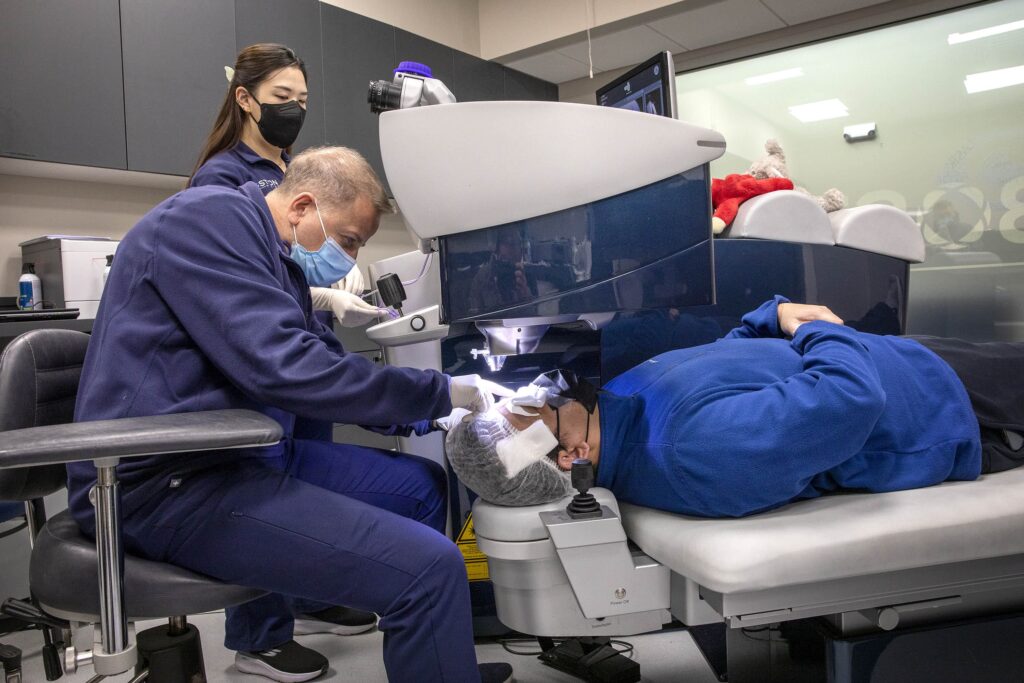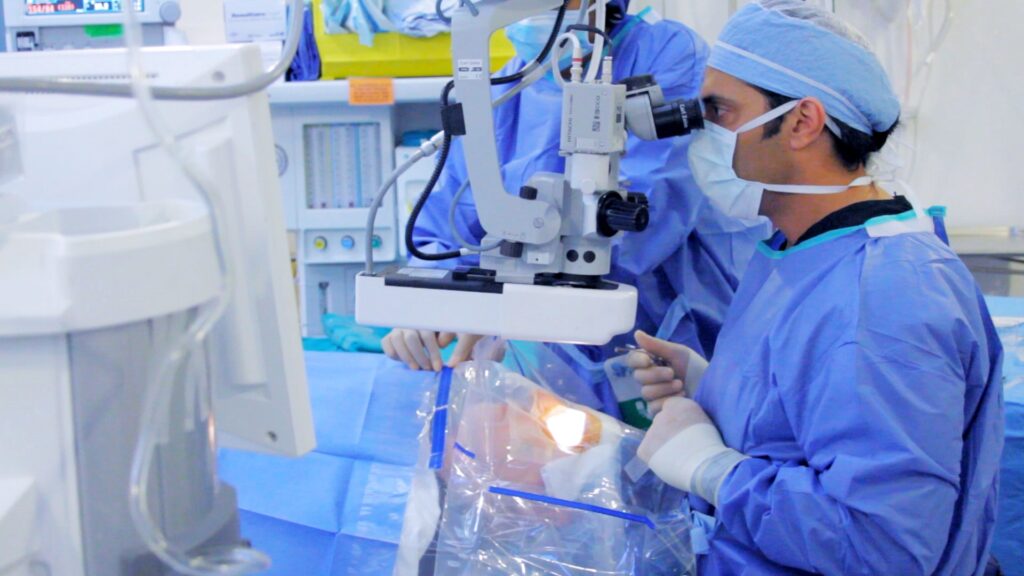LASIK eye surgery has revolutionized the way people correct their vision. This remarkable procedure offers a quick and effective solution for individuals who want to reduce their dependence on glasses or contact lenses. In this article, we will delve into the fundamentals of LASIK and explore the various aspects of the LASIK eye surgery experience.
The Fundamentals of LASIK Eye Surgery
Understanding what LASIK eye surgery entails is essential for anyone considering this procedure. So, what exactly is LASIK surgery?
LASIK, which stands for Laser-Assisted In Situ Keratomileusis, is a refractive surgical technique that reshapes the cornea to correct common vision problems such as nearsightedness, farsightedness, and astigmatism. By altering the shape of the cornea, light rays entering the eye can focus more accurately on the retina, leading to improved vision.
What is LASIK Eye Surgery?
LASIK eye surgery involves creating a thin flap on the cornea using a specialized laser or microkeratome blade. Once the flap is lifted, a second laser is used to reshape the underlying corneal tissue to the desired shape. The flap is then repositioned, acting as a natural bandage for the cornea.
The Science Behind LASIK
The science behind LASIK is a fascinating one. The cornea, which acts as a protective layer on the front of the eye, plays a crucial role in focusing light onto the retina. In individuals with refractive errors, the cornea is either too steep or too flat, causing light rays to be improperly focused.

LASIK works by precisely reshaping the cornea, allowing it to better focus light onto the retina. By using advanced laser technology, the surgeon can remove microscopic amounts of corneal tissue, altering its curvature and correcting the refractive error.
During the LASIK procedure, the surgeon first applies numbing eye drops to ensure the patient’s comfort. Once the eye is numb, a suction ring is placed on the eye to keep it steady and prevent any movement during the surgery. This step is crucial to ensure the accuracy of the laser treatment.
Once the suction ring is in place, the surgeon uses a femtosecond laser or a microkeratome blade to create a thin flap on the cornea. The choice of instrument depends on the surgeon’s preference and the patient’s specific needs. The flap is then gently lifted, exposing the underlying corneal tissue.
With the cornea exposed, the surgeon uses an excimer laser to reshape the corneal tissue. This laser emits a cool ultraviolet light that breaks the molecular bonds in the cornea, allowing precise removal of tissue. The surgeon carefully sculpts the cornea, removing microscopic layers to achieve the desired shape and correct the refractive error.
Once the cornea has been reshaped, the surgeon gently repositions the flap back into place. The natural adhesion of the cornea helps hold the flap in position, eliminating the need for stitches. The flap acts as a natural bandage, protecting the cornea as it heals.
After the surgery, the patient may experience some discomfort or mild irritation. This is normal and can be managed with prescribed eye drops and pain medication, if necessary. It is important for the patient to follow the post-operative instructions provided by the surgeon to ensure proper healing and minimize the risk of complications.
LASIK eye surgery has revolutionized the field of vision correction, providing millions of people with clearer vision and reduced dependence on glasses or contact lenses. It is a safe and effective procedure when performed by a skilled and experienced surgeon. However, like any surgical procedure, LASIK does carry some risks and potential side effects, which should be discussed with the surgeon during the consultation process.
Preparing for Your LASIK Surgery
Before undergoing LASIK eye surgery, there are several important steps to take to ensure a successful procedure and optimal results.
One of the first steps in preparing for your LASIK surgery is to schedule an initial consultation and comprehensive eye examination. This is a crucial part of the process as it allows the surgeon to evaluate your eye health and determine your eligibility for the procedure.
Initial Consultation and Eye Examination
The journey towards LASIK eye surgery begins with an initial consultation and comprehensive eye examination. During this appointment, the surgeon will evaluate your eye health, discuss your medical history, and perform various tests to assess your eligibility for LASIK.
These tests may include measurements of your corneal thickness, pupil size, and visual acuity. The surgeon will also discuss your visual goals and address any concerns or questions you may have.
It’s important to note that the initial consultation is not only an opportunity for the surgeon to evaluate your eligibility for LASIK, but also for you to ask any questions or express any concerns you may have. This is the time to have a thorough discussion about the procedure, its risks and benefits, and what you can expect during and after the surgery.
Once the surgeon has evaluated your eye health and determined that you are a suitable candidate for LASIK, they will provide you with detailed information about the procedure and what to expect during the recovery period.
Pre-Surgery Guidelines
Prior to your LASIK eye surgery, your surgeon will provide you with specific guidelines to follow to ensure a successful procedure and minimize the risk of complications. These guidelines may involve avoiding contact lenses for a certain period leading up to the surgery and refraining from using eye makeup or lotions on the day of the procedure.
It is crucial to carefully follow these instructions to ensure the best possible outcome and reduce the likelihood of any post-surgical complications.
In addition to these guidelines, your surgeon may also recommend certain lifestyle changes or adjustments in the days leading up to your LASIK surgery. These may include avoiding smoking or alcohol consumption, as well as getting enough rest and maintaining a healthy diet.
Furthermore, it is important to inform your surgeon about any medications you are currently taking, as some medications may interfere with the surgery or the healing process. Your surgeon will provide you with specific instructions regarding which medications to continue or discontinue prior to the procedure.
By following these pre-surgery guidelines and taking the necessary steps to prepare for your LASIK surgery, you can increase the chances of a successful procedure and achieve the best possible results.

The LASIK Surgery Procedure
The LASIK surgery procedure itself is quick and typically painless. Understanding the steps involved can help alleviate any concerns or anxieties you may have.
LASIK, which stands for Laser-Assisted In Situ Keratomileusis, is a popular refractive surgery that corrects vision problems such as nearsightedness, farsightedness, and astigmatism. It is a precise and effective procedure that can significantly improve your vision and reduce your dependence on glasses or contact lenses.
Step-by-Step Breakdown of the LASIK Procedure
The LASIK procedure typically takes around 15 minutes per eye. Here is a step-by-step breakdown of what to expect during the surgery:
- You will be positioned comfortably on a reclining chair, and numbing eye drops will be administered to ensure your comfort throughout the procedure.
- A small device known as a lid speculum will be used to gently hold your eyelids open, preventing you from blinking. This may feel slightly uncomfortable, but it is necessary for the surgeon to have access to your cornea.
- The surgeon will create a thin flap on the cornea using either a microkeratome blade or a laser. This portion of the procedure is typically painless. The creation of the flap is a crucial step as it allows the surgeon to access the underlying cornea for reshaping.
- Once the flap is created, the surgeon will lift it to expose the underlying cornea for reshaping. This is where the magic happens. The cornea, which plays a vital role in focusing light onto the retina, will be reshaped to correct your specific vision problem.
- A second laser, known as an excimer laser, will be used to remove precise amounts of corneal tissue, reshaping the cornea to the desired curvature. The excimer laser is a highly advanced technology that delivers ultraviolet light pulses to precisely remove tissue without generating heat.
- After the cornea has been reshaped, the surgeon will reposition the flap, allowing it to naturally adhere to the underlying corneal tissue. No sutures are typically required. The flap acts as a natural bandage, protecting the cornea and promoting faster healing.
- The surgeon will then repeat the same process on the other eye if necessary. Each eye is treated separately to ensure the best possible outcome.
Understanding the Role of the Surgeon
The success of your LASIK eye surgery greatly depends on the expertise and skill of your surgeon. During the procedure, the surgeon will carefully monitor and control the laser to ensure precise reshaping of the cornea. They will also guide you through the process, providing reassurance and answering any questions you may have.
Choosing an experienced LASIK surgeon with a proven track record of successful outcomes is crucial for achieving the best results from your LASIK eye surgery. The surgeon’s knowledge, experience, and attention to detail are essential in determining the success of the procedure and your overall satisfaction with the results.
Additionally, it’s important to note that LASIK surgery is not suitable for everyone. Your surgeon will conduct a thorough evaluation of your eyes and overall health to determine if you are a good candidate for the procedure. Factors such as the thickness of your cornea, the stability of your prescription, and the presence of any underlying eye conditions will be taken into consideration.
Overall, LASIK surgery offers a safe and effective solution for vision correction. By understanding the step-by-step breakdown of the procedure and the role of the surgeon, you can approach your LASIK surgery with confidence and look forward to a brighter, clearer future without the need for glasses or contact lenses.

Post-Surgery Expectations and Recovery
After the LASIK eye surgery procedure, it is normal to experience some minor discomfort. Understanding what to expect in terms of aftercare and recovery can help ensure a smooth healing process.
Immediate Aftercare and Recovery
Following your LASIK eye surgery, your surgeon will provide you with detailed instructions on how to care for your eyes during the initial recovery period. This may include using prescribed eye drops, wearing protective goggles while sleeping, and avoiding activities that may strain your eyes.
It is common to experience temporary side effects such as dry eyes, light sensitivity, and blurred vision during the first few days following surgery. These symptoms should gradually improve as your eyes heal.
Long-Term Vision Improvement and Maintenance
Most individuals experience significant improvement in their vision shortly after LASIK eye surgery. However, it is essential to maintain good eye health to ensure long-term visual stability.
Regular eye examinations, adherence to prescribed medications, and following your surgeon’s recommendations for eye care can help maintain the excellent vision achieved through LASIK eye surgery.
Potential Risks and Complications of LASIK
While LASIK eye surgery is considered safe and highly effective, as with any surgical procedure, there are potential risks and complications to be aware of.
Common Side Effects and How to Manage Them
Some individuals may experience common side effects after LASIK eye surgery, including dry eyes, halos or glares, and temporary vision fluctuation. These side effects are usually temporary and can be managed through the use of prescribed eye drops and other recommended measures.
It is crucial to keep your surgeon informed about any persistent or worsening side effects to ensure appropriate management and follow-up care.
When to Seek Medical Attention Post-Surgery
While complications are rare, it is important to recognize when to seek medical attention following LASIK eye surgery. If you experience severe pain, significant vision loss, or any concerning symptoms that do not improve with time, it is essential to contact your surgeon immediately.
Your surgeon will be able to assess your condition and provide necessary guidance or interventions to address any potential complications.
Conclusion
LASIK eye surgery offers a remarkable opportunity for individuals seeking freedom from glasses or contact lenses. By understanding the fundamentals of LASIK, preparing for the surgery, and knowing what to expect during the procedure and throughout the recovery process, you can make informed decisions and ensure a sharp focus and clear future with improved vision.
Other resources: Handy tips on CPAP masks

